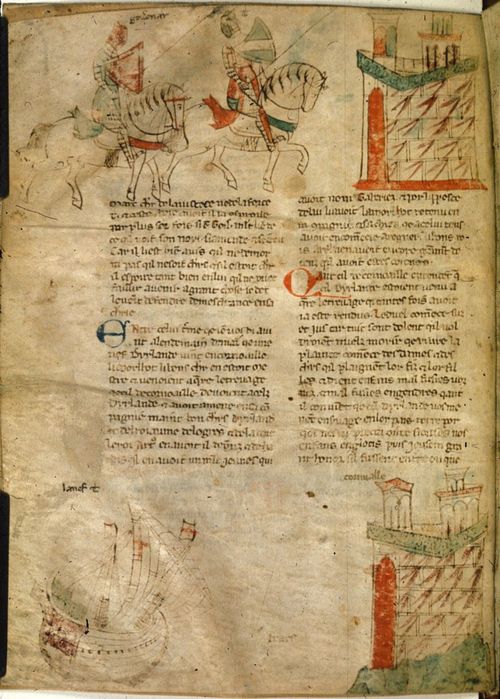
Miniatures of (above) Tristan and his mentor arriving at a castle and (below) Tristan arriving in Cornwall by ship; from Roman de Tristan en prose, last quarter of the 13th century or first quarter of the 14th century, Italy (Genoa), Harley MS 4389, f. 15v.
Tristan and Isolde are two of the great lovers of medieval
literature, and their doomed affair was retold in several different versions. The
British Library's Harley MS 4389 contains an incomplete copy of the Roman de Tristan in French prose, enlivened
by a large number of coloured drawings illustrating the story. They are not
the highly finished productions of elite illuminators, but nevertheless they
hold tremendous appeal.
The overall impression given by these pictures is of
movement and dynamism. The most common subjects are battles (between two
knights or as part of a chaotic mêlée) and travel. Ships recur again and again:
carrying passengers, approaching castles, even standing in the background of a
combat. In one stretch of six consecutive miniatures, only one does not contain
a ship. The visual emphasis on Tristan's travel transforms him into an
itinerant figure, wandering through the world of Cornwall,
Ireland and Gaul.
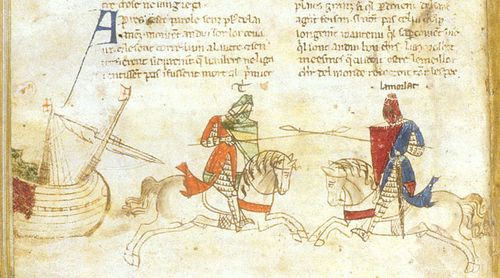
Detail of a miniature of Tristan (left) fighting Morholt; from Roman de Tristan en prose, last quarter of the 13th century or first quarter of the 14th century, Italy (Genoa), Harley MS 4389, f. 18v.
The drawings are sometimes simple and formulaic,
particularly when depicting battles between knights. The repetition creates a visual
continuity, as knights travel by ship through a landscape dotted with
opportunities for combat. But the illustrations do not wholly eschew the
specific, and some are immediately identifiable. Below, for example, is the
story of Tristan's birth. Tristan's parents were also ill-fated lovers: when
his father's kingdom was attacked, his mother fled in secret. Their story ended
with the king killed in battle, and the queen dead in childbirth. In this
picture, Tristan's mother lies dead in a field, and her waiting woman, holding
the infant Tristan, has been found by two knights who will take him to be
raised in exile by loyal retainers.
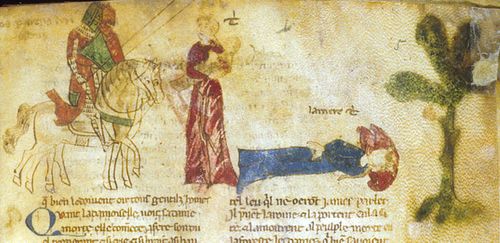
Detail of a miniature of the death of Tristan's mother; from Roman de Tristan en prose, last quarter of the 13th century or first quarter of the 14th century, Italy (Genoa), Harley MS 4389, f. 5r.
The best-known part of Tristan's story, in the Middle Ages
as well as today, was his love for Isolde. Tristan had been sent to Ireland
to retrieve the princess Isolde, his uncle King Mark's betrothed. On the way
back, the two fell in love when they unwittingly drank a love potion intended
for Isolde to share with her future husband. Their subsequent clandestine
affair became a source of great tension between Tristan and his uncle, who
suspected the truth and periodically plotted against Tristan, the most skilled
knight in his court.
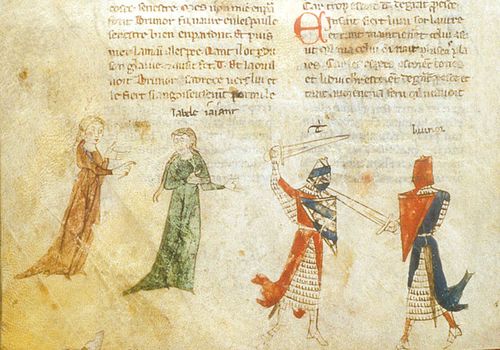
Detail of a miniature of Isolde (far left, in a rare appearance) and the Beautiful Giantess, watching the duel between Tristan and Brunor (far right); from Roman de Tristan en prose, last quarter of the 13th century or first quarter of the 14th century, Italy (Genoa), Harley MS 4389, f. 59v.
In the illustrations of Harley 4389, however, this iconic
affair is given very little attention. Isolde appears only rarely, even as
other women are given greater attention. Two miniatures, for example, are
devoted to the story of the Beautiful Giantess. Tristan and Isolde have travelled
to a country where it is the custom that the lord, Brunor, cut off the head of
any lady less beautiful than his own love, the Beautiful Giantess. Tristan kills
Brunor, but afterwards the people demand that he uphold custom and decapitate
the Beautiful Giantess, as Tristan showed himself the stronger knight and all
agree Isolde is the more beautiful lady. Tristan does not wish to, but, when
threatened with his own death, complies. The illustrators' choice of what to
draw, and what not to, creates a distinct reading of the text.
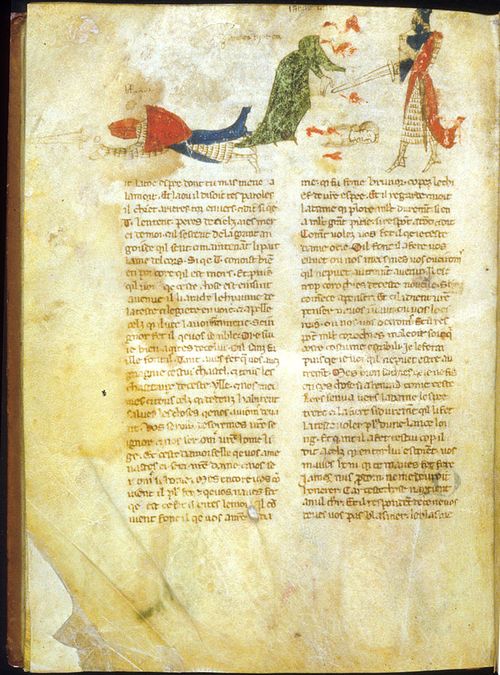
Detail of Brunor lying dead while Tristan decapitates the Beautiful Giantess; from Roman de Tristan en prose, last quarter of the 13th century or first quarter of the 14th century, Italy (Genoa), Harley MS 4389, f. 60v.
Nicole Eddy